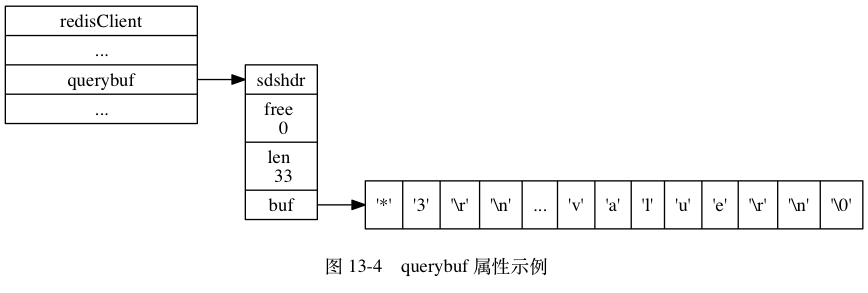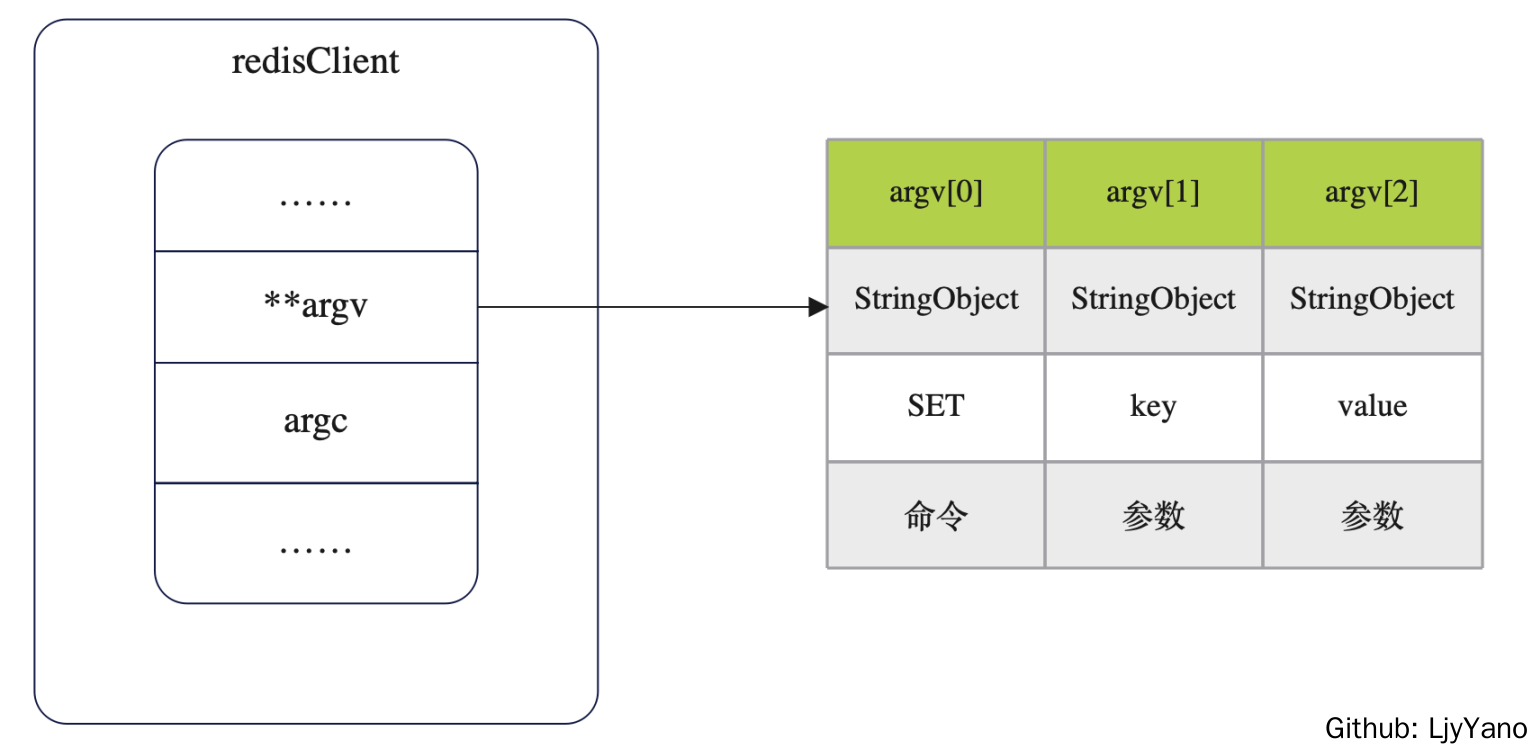Redis源码简洁剖析15—客户端原创
整体概述
Redis 一个服务器可以和多个客户端建立网络连接,每个客户端都可以向服务器发送命令请求,服务器接收客户端的命令,处理后将结果返回给客户端。
Redis 的文件事件处理器使用 I/O 多路复用,Redis 使用单线程单进程处理命令请求,与多个客户端进行网络通信。
每个连接了 Redis 服务器的客户端,服务器都建立了一个 redisClient 结构的客户端状态,保存了客户端当前的状态信息,以及执行相关功能时用到的数据结构。
Redis 服务器状态结构的 clients 属性是一个链表,保存了所有与服务器连接的客户端状态。
struct redisServer {
……
// 保存了所有客户端状态的链表
list *clients;
……
};
客户端属性
先贴一下 client 完整的数据结构:
typedef struct client {
uint64_t id; /* Client incremental unique ID. */
connection *conn;
int resp; /* RESP protocol version. Can be 2 or 3. */
redisDb *db; /* Pointer to currently SELECTed DB. */
robj *name; /* As set by CLIENT SETNAME. */
sds querybuf; /* Buffer we use to accumulate client queries. */
size_t qb_pos; /* The position we have read in querybuf. */
sds pending_querybuf; /* If this client is flagged as master, this buffer
represents the yet not applied portion of the
replication stream that we are receiving from
the master. */
size_t querybuf_peak; /* Recent (100ms or more) peak of querybuf size. */
int argc; /* Num of arguments of current command. */
robj **argv; /* Arguments of current command. */
int original_argc; /* Num of arguments of original command if arguments were rewritten. */
robj **original_argv; /* Arguments of original command if arguments were rewritten. */
size_t argv_len_sum; /* Sum of lengths of objects in argv list. */
struct redisCommand *cmd, *lastcmd; /* Last command executed. */
user *user; /* User associated with this connection. If the
user is set to NULL the connection can do
anything (admin). */
int reqtype; /* Request protocol type: PROTO_REQ_* */
int multibulklen; /* Number of multi bulk arguments left to read. */
long bulklen; /* Length of bulk argument in multi bulk request. */
list *reply; /* List of reply objects to send to the client. */
unsigned long long reply_bytes; /* Tot bytes of objects in reply list. */
size_t sentlen; /* Amount of bytes already sent in the current
buffer or object being sent. */
time_t ctime; /* Client creation time. */
long duration; /* Current command duration. Used for measuring latency of blocking/non-blocking cmds */
time_t lastinteraction; /* Time of the last interaction, used for timeout */
time_t obuf_soft_limit_reached_time;
uint64_t flags; /* Client flags: CLIENT_* macros. */
int authenticated; /* Needed when the default user requires auth. */
int replstate; /* Replication state if this is a slave. */
int repl_put_online_on_ack; /* Install slave write handler on first ACK. */
int repldbfd; /* Replication DB file descriptor. */
off_t repldboff; /* Replication DB file offset. */
off_t repldbsize; /* Replication DB file size. */
sds replpreamble; /* Replication DB preamble. */
long long read_reploff; /* Read replication offset if this is a master. */
long long reploff; /* Applied replication offset if this is a master. */
long long repl_ack_off; /* Replication ack offset, if this is a slave. */
long long repl_ack_time;/* Replication ack time, if this is a slave. */
long long repl_last_partial_write; /* The last time the server did a partial write from the RDB child pipe to this replica */
long long psync_initial_offset; /* FULLRESYNC reply offset other slaves
copying this slave output buffer
should use. */
char replid[CONFIG_RUN_ID_SIZE+1]; /* Master replication ID (if master). */
int slave_listening_port; /* As configured with: REPLCONF listening-port */
char *slave_addr; /* Optionally given by REPLCONF ip-address */
int slave_capa; /* Slave capabilities: SLAVE_CAPA_* bitwise OR. */
multiState mstate; /* MULTI/EXEC state */
int btype; /* Type of blocking op if CLIENT_BLOCKED. */
blockingState bpop; /* blocking state */
long long woff; /* Last write global replication offset. */
list *watched_keys; /* Keys WATCHED for MULTI/EXEC CAS */
dict *pubsub_channels; /* channels a client is interested in (SUBSCRIBE) */
list *pubsub_patterns; /* patterns a client is interested in (SUBSCRIBE) */
sds peerid; /* Cached peer ID. */
sds sockname; /* Cached connection target address. */
listNode *client_list_node; /* list node in client list */
listNode *paused_list_node; /* list node within the pause list */
RedisModuleUserChangedFunc auth_callback; /* Module callback to execute
* when the authenticated user
* changes. */
void *auth_callback_privdata; /* Private data that is passed when the auth
* changed callback is executed. Opaque for
* Redis Core. */
void *auth_module; /* The module that owns the callback, which is used
* to disconnect the client if the module is
* unloaded for cleanup. Opaque for Redis Core.*/
/* If this client is in tracking mode and this field is non zero,
* invalidation messages for keys fetched by this client will be send to
* the specified client ID. */
uint64_t client_tracking_redirection;
rax *client_tracking_prefixes; /* A dictionary of prefixes we are already
subscribed to in BCAST mode, in the
context of client side caching. */
/* In clientsCronTrackClientsMemUsage() we track the memory usage of
* each client and add it to the sum of all the clients of a given type,
* however we need to remember what was the old contribution of each
* client, and in which categoty the client was, in order to remove it
* before adding it the new value. */
uint64_t client_cron_last_memory_usage;
int client_cron_last_memory_type;
/* Response buffer */
int bufpos;
char buf[PROTO_REPLY_CHUNK_BYTES];
} client;
套接字描述符
typedef struct client {
……
// 记录客户端正在使用的套接字描述符
int fd;
……
}
标志
客户端的标志属性 flags 记录了客户端的角色(role),以及客户端目前所处的状态:
typedef struct redisClient {
// ...
int flags;
// ...
} redisClient;
具体值可参考:《Redis 设计与实现-客户端属性》,flag 例子:
# 客户端是一个主服务器
REDIS_MASTER
# 客户端正在被列表命令阻塞
REDIS_BLOCKED
# 客户端正在执行事务,但事务的安全性已被破坏
REDIS_MULTI | REDIS_DIRTY_CAS
# 客户端是一个从服务器,并且版本低于 Redis 2.8
REDIS_SLAVE | REDIS_PRE_PSYNC
# 这是专门用于执行 Lua 脚本包含的 Redis 命令的伪客户端
# 它强制服务器将当前执行的命令写入 AOF 文件,并复制给从服务器
REDIS_LUA_CLIENT | REDIS_FORCE_AOF | REDIS_FORCE_REPL
输入缓冲区
客户端状态的输入缓冲区用于保存客户端发送的命令请求:
typedef struct redisClient {
// ...
sds querybuf;
// ...
} redisClient;
如果客户端向服务器发送了以下命令请求:
SET key value
客户端状态的 querybuf 属性将是一个包含以下内容的 SDS 值:
*3\r\n$3\r\nSET\r\n$3\r\nkey\r\n$5\r\nvalue\r\n
展示了这个 SDS 值以及 querybuf 属性的样子:
命名及命令参数
在服务器将客户端发送的命令请求保存到客户端状态的 querybuf 后,服务器会分析该命令,将得到的命令参数、命令参数的个数分别保存到客户端状态的 argv 属性和 argc 属性中:
typedef struct redisClient {
// ...
robj **argv;
int argc;
// ...
} redisClient;
命令的实现函数
当服务器从协议内容中分析并得出 argv 属性和 argc 属性的值之后, 服务器将根据项 argv[0] 的值,在命令表中查找命令所对应的命令实现函数。
当程序在命令表中成功找到 argv[0] 所对应的 redisCommand 结构时, 它会将客户端状态的 cmd 指针指向这个结构:
typedef struct redisClient {
// ...
struct redisCommand *cmd;
// ...
} redisClient;
struct redisCommand {
char *name;
redisCommandProc *proc;
int arity;
char *sflags; /* Flags as string representation, one char per flag. */
uint64_t flags; /* The actual flags, obtained from the 'sflags' field. */
/* Use a function to determine keys arguments in a command line.
* Used for Redis Cluster redirect. */
redisGetKeysProc *getkeys_proc;
/* What keys should be loaded in background when calling this command? */
int firstkey; /* The first argument that's a key (0 = no keys) */
int lastkey; /* The last argument that's a key */
int keystep; /* The step between first and last key */
long long microseconds, calls, rejected_calls, failed_calls;
int id; /* Command ID. This is a progressive ID starting from 0 that
is assigned at runtime, and is used in order to check
ACLs. A connection is able to execute a given command if
the user associated to the connection has this command
bit set in the bitmap of allowed commands. */
};
每个命令所对应的处理函数在是下面的 table:
struct redisCommand redisCommandTable[] = {
{"module",moduleCommand,-2,
"admin no-script",
0,NULL,0,0,0,0,0,0},
{"get",getCommand,2,
"read-only fast @string",
0,NULL,1,1,1,0,0,0},
{"getex",getexCommand,-2,
"write fast @string",
0,NULL,1,1,1,0,0,0},
……
}
输出缓冲区
保存执行命令所得的命令回复。
客户端的固定大小缓冲区由 buf 和 bufpos 两个属性组成:
typedef struct redisClient {
// ...
char buf[REDIS_REPLY_CHUNK_BYTES];
// 记录了 buf 数组目前已使用的字节数量
int bufpos;
// ...
} redisClient;
可变大小缓冲区由 reply 链表和一个或多个字符串对象组成:
typedef struct redisClient {
// ...
list *reply;
// ...
} redisClient;
通过使用链表来连接多个字符串对象, 服务器可以为客户端保存一个非常长的命令回复, 而不必受到固定大小缓冲区 16 KB 大小的限制。展示了一个包含三个字符串对象的 reply 链表。
客户端的创建与关闭
创建普通客户端
使用 connect 函数连接到服务器,服务器调用连接事件处理器,为客户端创建对应的客户端状态,并将其添加到服务器状态结构 clients 链表的末尾。
关闭普通客户端
关闭普通客户端的原因:
- 客户端进程退出或被杀死,客户端与服务端的网络连接被关闭
- 客户端向服务端发送了不符合协议格式的命令请求
- 客户端成为了 CLIENT KILL 命令的目标
- 客户端的空转时间超过 timeout 配置选项的值
- 客户端发送的命令请求大小,超过了深入缓冲区的限制大小(默认为 1GB)
- 服务端返回给客户端的数据超过了输出缓冲区的限制大小












